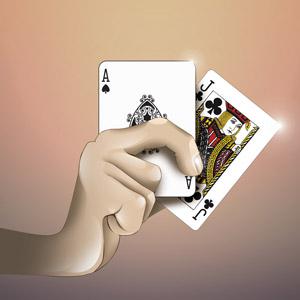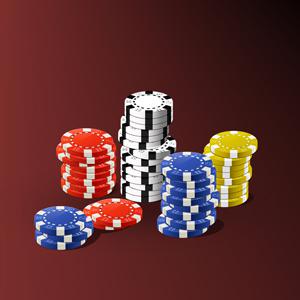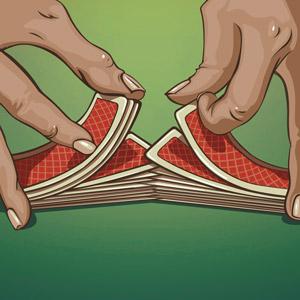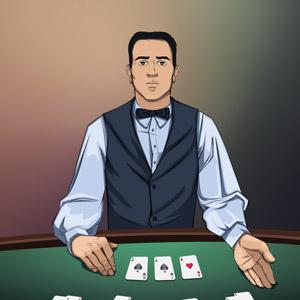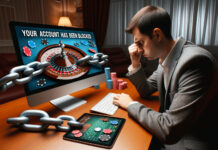So you want to be a blackjack dealer. Great! It’s the next step up from your blackjack hobby, and when you really get it right, it can be just as rewarding as playing blackjack, if not more. Plus, it’ll greatly enhance your skills when you want to take a break from dealing and get back to winning real money at blackjack.
First off, your role as the dealer is one that you need to take seriously. It’s not just a matter of being the person to handle the playing deck – the act of dealing is the most basic part. Beyond shuffling, dealing to individual players, more shuffling… you are completely in charge of the entire game. You’re running the show! Or at least you should be, if you’re doing it right.
Among your many responsibilities are:
- Managing bets
- Guiding clueless players
- Facilitating a smooth game
- Handling difficult players with grace and class
- Ensuring that everyone feels comfortable and confident that you know exactly what you’re doing
Remember: the game and your guests’ enjoyment are in your hands.
It doesn’t matter whether you’re looking to throw a casino-themed party for your best friend’s birthday or seriously thinking about looking for a casino job and moving to Vegas, you’ll need to work on your skills. And while you won’t magically transform into a professional dealer overnight, here’s a thorough crash course on how to deal blackjack – get started on the essentials now.
Step 1: Learn the rules (ALL of them!)
Now obviously, the game itself is the same – whichever side of that table you’re on, blackjack dealer rules aren’t going to change. But for you, different levels of ease and mastery are required. You’ve seen those bumbling new players, and you’ve probably been one of them yourself.
If you’re reading this guide and haven’t actually mastered playing the game, you might want to consider bookmarking this article and coming back to it after you’ve already covered the foundation. If you’re looking for a solid summary, check out our easy beginner’s guide to blackjack for an overview of the rules and winning strategies.
How to win
Okay, hopefully you know by now that the object of the game is to beat the dealer, and typically the player can accomplish this with a final hand that is:
1) higher than the dealer’s hand, and
2) not exceeding a total of 21.
The second way to win is just to receive a lucky initial hand that equals exactly 21, also known as a natural, or a blackjack – that’s if the dealer does not also get blackjack.
The player can also win the hand if the dealer “busts”: meaning that he draws cards and reaches a final hand of over 21.
A quick recap
Unlike many other card games, blackjack players don’t go up against each other but are instead competing with only the dealer. Each player is initially dealt two cards face up; the dealer receives two cards, one of which is dealt face down.
The players may draw additional cards in an effort to improve their hand. Then, the dealer reveals his hand and must hit until the cards total 17 or more.
Some establishments also include a “soft 17” rule: the dealer is required to draw on a hand with a total of 17 if it includes an Ace. If the player outperforms the dealer, he or she wins.
The equipment
The first thing each player needs is something to bet with. Before they can join the game and start playing, participants must exchange cash for casino tokens. Typically these come in the following denominations and colors:
$1: white chips
$5: red chips
$25: green chips
$100: black chips
$500: purple chips
Of course, if you play at with us at Planet 7 Casino, we make it easy to navigate to the Cashier page to make a quick deposit with one of many payment method options and get some virtual chips.
The next element is the table. As with many other table games, blackjack involves a green velvet-lined surface with wooden trim. The table has a semi-circular shape, with the players seated around the curved side and the dealer behind the straight end.
Blackjack tables have several common features:
- The dealer’s shoe is the device that holds the decks of playing cards in use.
- The currency slot is where cash is placed when exchanged for chips.
- The dealer keeps the chip tray in front of him or her for handling payouts or gathering chips from losing hands.
- Individual players’ betting areas are marked by circles or squares in front of each seat, and this is where their chips are placed when bets are made.
The seat to the dealer’s left is first base, and the seat to the right is third base. The surface of the table is typically also marked with the rules of the game – payout ratios, bet limits, and any other relevant conditions.
The cards
Depending on the specific game or casino, the number of decks in use can range from one to eight 52-card decks.
Numbered cards (2 through 10) are played at face value.
Face cards (Jack, Queen, and King) are valued at 10.
An Ace may count as 1 or 11 points, depending on which value is more beneficial to the player’s hand.
The specifics
- The dealer shuffles the cards thoroughly.
- A player cuts the deck by inserting a plastic cut card.
- The dealer burns the top card.
- At the start of each round and before the dealing begins, players place their bets by moving their chips into the designated betting areas.
- Two cards are dealt face up to each of the players, and two are dealt to the dealer with one face down – this is called the hole card. The dealer always begins with the player on his left and moves clockwise, dealing each player one card face up. He/she then deals himself one card face down. He/she deals a second round of face up cards to the players and one for himself.
- a) If his/her face up card is an Ace, the dealer offers “insurance,” a side bet that pays out if the dealer’s hole card is worth 10 points – in other words, if he/she has a natural blackjack.
- b) With a 10 or Ace showing, the dealer checks his/her hole card. If it’s a blackjack, he/she reveals it immediately. All wagers lose except for players who bought insurance. Players who also have blackjack receive their original bet back; this is called a push.
- The player now must choose to hit or stand. In some cases, he/she may also choose to double, split, or surrender.
- a) Hit vs. Stand: When a player wants one or more additional cards, he says “Hit,” or taps the table. If he/she feels that his hand is best left alone, he/she says, “stand,” or gestures with a quick horizontal motion.
- b) The player also has a few other options in special cases. Double: if the player’s hand totals 9, 10, or 11, he/she can double his bet in exchange for a single additional card. It’s placed face down and is not revealed until bets are settled at the end of the hand. Split: if he/she has two cards of the same value, the player can separate them into two individual hands and double his/her bet. After receiving a second card for each hand, he/she may hit, stand, or double as usual. If the original two cards are Aces, he/she may only receive one additional card. However, if the dealer has a blackjack and the player receives a post-split blackjack, it does not count as a natural.
- c) Surrender: this option is not universally available in all casinos. After receiving his/her initial two cards, the player can forfeit half of his/her bet and choose not to play the hand.
- Once the players have finished their turns, the dealer reveals his/her hole card.
- With a total of less than 17 points, the dealer must hit. According to certain game rules, if he/she has a 17-point hand that contains an Ace (a soft 17), he/she must also hit.
- If the dealer goes over 21 points, he/she busts. Any player who has not also bust will win. Otherwise, whoever has the higher point value will win.
- The dealer collects all losing bets and awards payouts, again from left to right.
Payouts
Regular Win: 1:1
Blackjack Win: 3:2
Insurance: 2:1
Push (a tie, including when both player and dealer have blackjack): Bet Returned
Did you get everything? We suggest that you review whatever you don’t know completely by heart. The best way to internalize it all? Practice, practice, practice! That includes being completely familiar with the game – play online here at Planet 7 Casino to solidify your understanding from the player’s standpoint.
Step 2: Learn how to shuffle
You know what to do when you’re a participant in the game; now figure out what to do once you’re on the other side of that table. Learning how to deal blackjack starts with your first task: shuffling.
If you and your friends have ever played blackjack or any other card games in the past, it’s highly likely that you’ve learned to deal cards, however clumsily that might be. Typically in amateur settings, the players will take turns being the dealer. However, if you’re just playing solely the part of the dealer, your painstakingly slow shuffling and occasional mishaps just aren’t going to cut it.
This step is easy to practice – watch a few tutorials on YouTube. If you’re at home enjoying a session at Planet 7, keep a spare deck of cards on your desk so you can alternate between playing blackjack online and honing your shuffling skills.
Step 3: Learn how to deal.
You’ve mastered the riffle shuffle and general techniques, now include the part where you actually get the cards from out of the deck and into the players’ hands. This should be smooth, across the distance of the table and with accuracy. The technique is called “sailing cards.”
How do you learn? More how-to videos and diligent practice. You can simply clear off your desk at home and practice, or volunteer to play dealer if you’re having a poker or table game night with friends.
Step 4: Learn how to handle chips.
There’s no guide on how to accomplish this – it’s all about familiarity and muscle memory. Familiarize yourself about how the surface of chips feel and their size and weight. Practice sweeping and stacking them until you can handle the chips effortlessly.
Step 5: Learn the lingo.
Terminology is important, even more so for a dealer than for a player. If you come off as a novice, the players will, at best, silently distrust your methods and general competence, making it difficult for them to be completely at ease; at worst, unruly players will heckle you and disrupt the game for everyone else involved. It’s not a pleasant scenario, and it’s one you should avoid at all costs.
Step 6: Figure out the math.
So far, everything has been pretty straightforward – nothing you can’t handle with a bit of dedicated repetition. This next part is crucial to your success as a dealer and requires a little more memorizing.
Familiarize yourself with the payouts. The most common payouts are 1:1, so a $25 bet will lead to a $25 payout. However, when a player wins with a blackjack, the math for a 3:2 payout can be trickier. This is just something you need to memorize, period.
Keep practicing – the most embarrassing mistake you can make as a dealer is if you calculate something incorrectly.
Don’t forget to add up the points! Just because the hand is a bust, doesn’t mean you don’t have to bother with adding. The dealer should always announce the total points of each player’s hand, regardless of what it amounts to. This is also something you need to practice, just like you would with flashcards before a math test.
Step 7: Ensure fairness.
A big part of your multitasking responsibilities will be about keeping the game fair, and that means keeping an eye out for card counters or cheaters. While blackjack card counting is legal, you’ll still want to be able to spot it easily – casinos tend not to be fans of card counters, and the one you work at will likely feel the same way.
A few ways to potentially deter cheaters and card counters – engage the player in conversation to distract him. Someone who is shutting down attempts to make small talk may be trying to focus on counting cards. You can also try to shuffle more frequently or at a faster rate.
Look out for lone players who are sitting close together, especially when there are empty seats available. Actual strangers typically avoid sitting directly next to others, and if they are, they may be accomplices working together to cheat.
In general though, if the casino management knows what it’s doing, you shouldn’t have to do much more than stay alert and observant – security guards and surveillance cameras should take care of the rest.
Step 8: Refine your persona as a professional blackjack dealer
Another challenging aspect of your job as the blackjack dealer is that everything needs to look like second nature. Why? Because, it should be pretty darn close to that. It’s tiring to always be thinking about how the game should go, wondering how the players feel, and looking out for mistakes. You can avoid this. Just practice enough so that the balancing act is no longer such a conscious effort, and you won’t be scrambling to fix or hide mistakes.
Your hands should know what to do. The payouts for various bets should be more or less memorized. Hone the basic math skills you need sufficiently to be able to perform without getting too anxious or stressed. That’s because your job isn’t just to keep the game going. You’re the host of this event, and the players are your guests.
Be prepared
It’s possible that your dealer persona will come naturally to you. However, whether or not that’s the case, it’s a good idea to be prepared. When you’re at a casino, just observe. Watch how different dealers interact with the players at their table. Pay attention to how they treat polite players and rude ones. Look for differences in their dealing styles. When you sit down at the table, try making conversation with them. Make mental notes of what to do and what not to do (It might also be a good idea to see which dealers receive the most tips and try to work out why that might be).
Once you’ve gathered some data, start incorporating habits into your own routine. Practice with your friends, or just set up a table on your own and go through a few rounds to test things out. Don’t forget to think about how a professional carries him or herself. Stand up straight, move efficiently and smoothly, keep your conversations courteous and light, and it will all come together naturally.
If you’ve honed all the necessary practical skills, congratulations. You’re ready to start! One more thing to keep in mind – in the world of casinos, game rules, technology, and even laws are changing constantly. Don’t let yourself get lazy! If the game changes, then techniques will too, not just for the players but for the dealers as well.
Get to it!
As we’ve shown, the rules of dealing are consistent with the rules of playing. However, your responsibilities as the person running the show will be very different. You’ll need to pay attention to more aspects of the game. As a player, you just need to pay attention to your hand. If you’re past the beginner stage, you watch what happens, factor in opponents’ hands, etc. Strategy comes into the picture. But the bare minimum is just being able to count up your points and decide what actions to take. The bare minimum of being a dealer is a lot more than that. Be sure to study our guide, keep practicing and reading up on techniques, and before long, you’ll be dealing blackjack professionally along with the best of the best.


